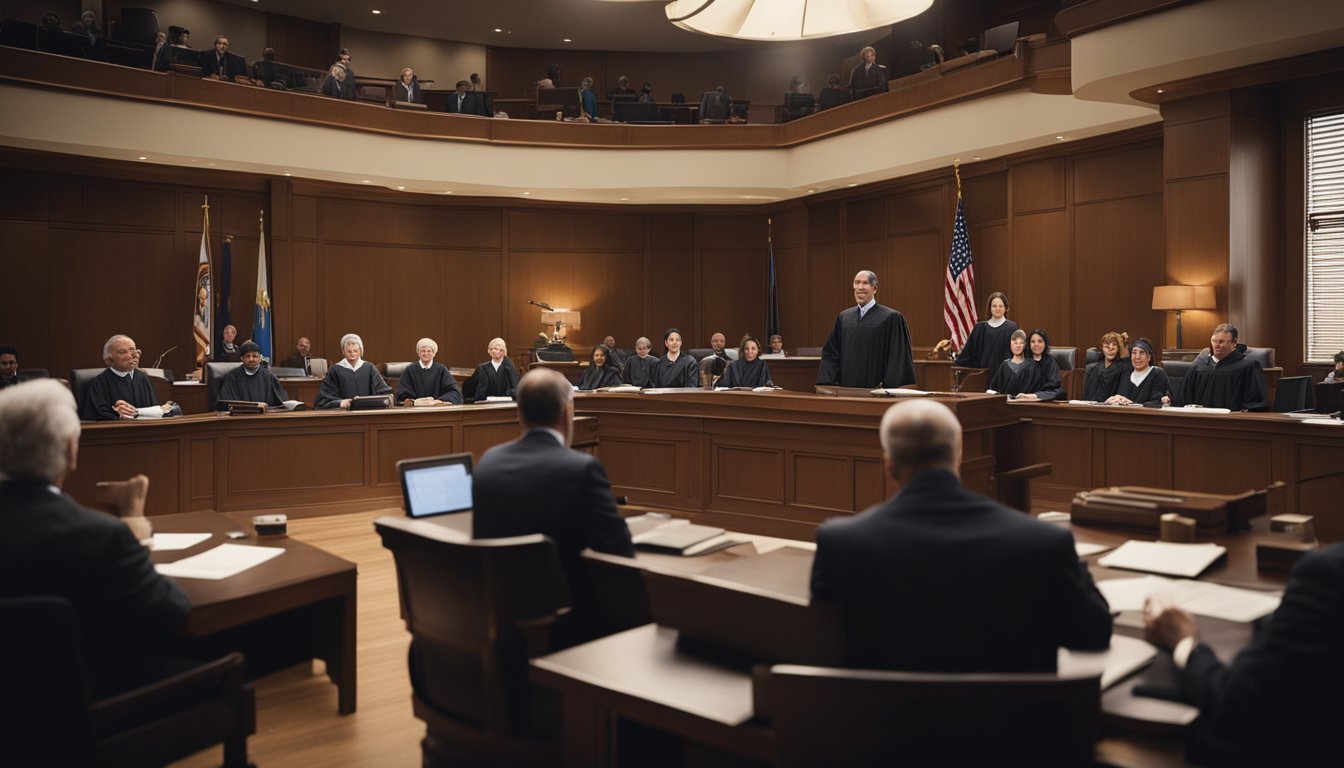5 Haunting Documentaries on Kidnapping Cases in Ohio
Unveiling Chilling Truths
Ohio has been the backdrop for some of the most harrowing kidnapping cases in recent history. From the heart-wrenching ordeals faced by Michelle Knight, Amanda Berry, and Georgina DeJesus in Cleveland to other tragic abductions, these stories have been captured in various documentaries that provide insight into the resilience of the human spirit and the dark realities of such crimes.
This article highlights five compelling documentaries that delve into these profound kidnapping cases, shedding light on both the victims’ experiences and the relentless pursuit of justice. These films not only offer a somber look at the crimes themselves but also honor the strength and bravery of those who survived against immeasurable odds.
1) The Cleveland Abduction (2015)
The Cleveland Abduction documents one of Ohio's most harrowing kidnapping cases. From 2002 to 2004, Ariel Castro kidnapped Michelle Knight, Amanda Berry, and Gina DeJesus, holding them captive in his Cleveland home.
The film highlights the unimaginable ordeals faced by the victims. They were kept in deplorable conditions, subjected to physical and mental abuse for over a decade.
Their escape in May 2013, which was facilitated by Amanda Berry taking a courageous opportunity to seek help, led to Castro's arrest and subsequent conviction.
The documentary sheds light on the resilience and strength of the survivors, as well as the intense media coverage and community reaction following their rescue.
For more details on this documentary, visit IMDb.
2) Taken: The Tanya Kach Story (2024)
In 1996, 14-year-old Tanya Kach went missing from McKeesport, Pennsylvania. Her abductor, Tom Hose, a security guard at her school, held her captive for a decade.
Lifetime's "Taken: The Tanya Kach Story" re-enacts her eerie confinement and eventual escape.
The movie delves into Tanya's isolation and manipulation by Hose. She was held in his home, often kept hidden to avoid detection.
Tanya's resilience and eventual escape are the focal points of the film, highlighting the psychological trauma endured.
For more details about the film, visit IMDb.
3) Kindness of Strangers: The Story of Shawn Hornbeck
Shawn Hornbeck disappeared on October 6, 2002, while riding his bike near his home in Richwoods, Missouri. His case would go unsolved for four long years.
In January 2007, a breakthrough came when police discovered both Shawn, now fifteen, and another missing boy, Ben Ownby, in a suburban apartment. Their recovery became known as the "Missouri Miracle."
The documentary showcases the resilience of Shawn and his family, who never gave up hope. It also highlights the critical role that chance encounters and the dedication of law enforcement played in bringing Shawn back home.
"More Information" (2015)
4) The Ariel Castro Kidnappings
In this chilling documentary, viewers are taken through the horrific events orchestrated by Ariel Castro between 2002 and 2004. Castro abducted Michelle Knight, Amanda Berry, and Gina DeJesus from Cleveland, Ohio. He imprisoned these women in his home for nearly a decade.
The film highlights the intense psychological and physical abuse the victims endured. Castro manipulated and brutalized them, while they struggled to maintain hope in their dire situation. Their tenacity and resilience are central themes in the narrative.
The documentary also focuses on the successful escape in 2013. Amanda Berry managed to break free and seek help, which led to the rescue of the other captives. The aftermath of their liberation and Castro's eventual arrest and sentencing are explored in detail.
Adding to the poignancy, the filmmakers include first-hand accounts from the survivors. These harrowing stories provide an intimate look at the emotional and physical toll of their captivity and the long road to recovery they face.
For more information, see The Cleveland Kidnappings on IMDb (2021).
5) The Mysterious Disappearance of Aliza Sherman
Aliza Sherman, a nurse from Beachwood, Ohio, was brutally murdered on March 24, 2013. She was fatally stabbed outside her lawyer's office in Downtown Cleveland.
Witnesses heard her screams and called 911.
Despite the severity of the attack, the case remains unsolved to this day. Sherman was stabbed multiple times in her face, neck, ear, and back.
She was rushed to the hospital, but she succumbed to her injuries.
Family and friends have been tirelessly seeking justice ever since.
The details surrounding her murder have puzzled investigators for over a decade.
Her daughter, Jennifer Sherman, has been vocal about her quest to find answers.
In recent years, Ohio's Bureau of Criminal Investigation has taken over the case. Their involvement has raised hopes for new leads and potential breakthroughs.
For more information, you can visit:
Aliza Sherman Murder Case on Wikipedia (2023)
Overview of Kidnapping Cases in Ohio
Ohio has been the site of several high-profile kidnapping cases that have drawn nationwide attention. These cases often share common patterns and have profound impacts on communities and law enforcement practices.
Historical Context
Kidnapping cases in Ohio have a history that spans several decades. Particularly notable is the 2013 case involving Ariel Castro, who held three women captive in Cleveland for over ten years. These crimes have often shocked the public and prompted changes in community safety measures.
Ohio's history with kidnapping cases shows a pattern of abductions occurring in populated neighborhoods and sometimes going unnoticed for extended periods. Law enforcement agencies have had to adapt and improve their tactics in response to these troubling events.
Common Patterns and Trends
Many Ohio kidnapping cases reveal disturbing similarities. Victims are often abducted from public spaces and held in residential properties. Perpetrators might manipulate victims psychologically to maintain control. These kidnapping events frequently involve multiple victims who are discovered only after long periods.
Another observed trend is the significant role of community and media in the eventual rescue of victims. Media coverage and public awareness often aid in the recovery process. These common patterns help guide law enforcement in prevention and investigative efforts, highlighting the importance of vigilant communities and informed policing strategies.
Psychological Impact on Victims
Kidnapping incidents inflict severe emotional and mental strain on the victims. They often endure prolonged trauma and need robust support systems and resources for recovery.
Trauma and Recovery
Victims of kidnapping often experience post-traumatic stress disorder (PTSD), anxiety, and depression. The initial trauma, combined with prolonged fear and uncertainty, leaves deep psychological scars. These individuals might face nightmares, flashbacks, and difficulty trusting others.
Recovery is a lengthy process. Individual therapy, including cognitive-behavioral therapy (CBT) and trauma-focused therapy, plays a crucial role. Group therapy sessions provide a chance for shared experiences, offering comfort through community support.
Support Systems and Resources
Strong support systems are essential for aiding recovery. Families play a critical role, offering stability and emotional support. Counseling services provided by schools and community organizations are valuable.
Non-profit organizations often provide specialized resources such as legal aid, emergency shelter, and financial assistance. Online forums and support groups facilitate peer interaction, helping victims feel less isolated and more understood on their path to healing.
Legal Proceedings and Case Outcomes
Legal proceedings involving kidnapping cases in Ohio reveal a mix of high-profile cases and the state's regulatory framework. Analyzing notable verdicts and applicable Ohio laws illustrates the complexities of handling such crimes.
Notable Cases and Verdicts
The Cleveland Captives: In 2013, Ariel Castro was sentenced to life plus 1,000 years for kidnapping and holding three women captive for a decade in Cleveland. His arrest, trial, and eventual conviction highlighted flaws in the law enforcement response and led to media scrutiny.
Elizabeth Smart Case: Although not in Ohio, the national impact influenced how similar cases were prosecuted. Brian David Mitchell received a life sentence, which underscored the severe penalties applied in such crimes.
Paul Miles Case: In 2010, Paul Miles received a 35-year sentence for abducting and assaulting a young girl in a Cleveland suburb. This case reinforced the legal system’s zero tolerance for such heinous acts.
Laws and Regulations in Ohio
Kidnapping Laws: Ohio defines kidnapping under Ohio Revised Code Section 2905.01. The statute mandates that the act of removing or restraining a person by force or threat for ransom, to facilitate a felony, or to terrorize, among other reasons, constitutes kidnapping.
Penalties: Ohio imposes severe penalties, including lengthy prison sentences and hefty fines, against offenders convicted of kidnapping. Sentencing varies based on the victim's age, harm inflicted, and other aggravating factors.
Sex Offender Registration: Convicted kidnappers, particularly those involving minors or with sexual motivations, must register as sex offenders. This requirement aims to monitor and restrict their activities post-release, enhancing community safety.
Victim Support: Ohio law provides robust support systems for victims, including counseling, financial aid, and legal assistance. These measures ensure victims and their families receive comprehensive support during and after traumatic events.





